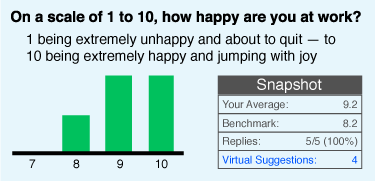 Rand Fishkin, CEO of SEOmoz, has a corporate culture of transparency. Rand spoke to the local chapter of the Entrepreneur Organization recently. Based on the story that he shared with us, it sounded like he was a person that was not very transparent in the early days of Moz. However, today Rand is more like Ryan Gosling (though clearly better looking) and is happy to share all. A recent Forbes article ranked Rand #1 in an article: 10 Leaders Who Are Not Afraid To Be Transparent.
Rand Fishkin, CEO of SEOmoz, has a corporate culture of transparency. Rand spoke to the local chapter of the Entrepreneur Organization recently. Based on the story that he shared with us, it sounded like he was a person that was not very transparent in the early days of Moz. However, today Rand is more like Ryan Gosling (though clearly better looking) and is happy to share all. A recent Forbes article ranked Rand #1 in an article: 10 Leaders Who Are Not Afraid To Be Transparent.
If there’s a President in the world of transparency, it’s definitely Rand. A couple days ago, he posted his own performance review. In it, you can see that Rand challenges himself aggressively. SEOmoz has made their funding decks open to the public, which is unheard of. They share all of their failures (and their successes) with the world so others can learn from their experiences. This impacts their company culture.
How Is Company Culture Created?
Someone once said to me that if you don’t create your own culture, you will get a culture by default. The culture that I have been forming at thinkspace for three years has been focused around a few different pillars.
[listdot]
- Core Values
- One Page Strategic Plan
- Daily Huddles
- Top Grading
[/listdot]
A blog post on each of these things would barely be sufficient as there are books written on each topic. None the less, I’ll take a stab in the upcoming months describing how we use those pillars at thinkspace to help organizational efficiency and create company culture.
You Get The Culture You Tolerate
Even with these pillars in place, there needs to be consistency across the company. Bending rules for just one person and not allowing other people to do the same thing creates an unpleasant confusing work environment. It’s bad for the other employees and it’s bad as a leader. No one should ever be above the rules. I’m also not a fan of “It’s my company so it’s my way or the highway”.
Employees Are People Not Cyborgs
The hard part about this is when you’re just starting up a company, it’s extremely challenging to think about the various things that might come up because there’s a wild card. Employees are human beings, not cyborgs. Depending on the people you hire, they will request stuff that you couldn’t even begin to imagine. Mix in entitlement, expectations, personality, and prior baggage from other managers and companies where they have worked and it creates an infinite number of things that might come up.
The flip side to this is become a cyborg yourself and run things in a black and white manner. That is a culture of machines. The problem with this is there’s no humanity in running things like a cyborg. I choose to run a company that focuses on being remarkable and human to our customers and can’t be done without humans. I can’t turn myself into a cyborg.
Screw Appealing to Gen-Y
Some leaders try to figure out all the different types of generational differences between boomers, Gen-X, Gen-Y, and Millennials. I was that guy. I’ve read tons of articles, graphs comparing this generation versus that generation, heard at least three expert speakers on this subject with my last person being Jason Dorsey at the EO MIT Entrepreneurial Masters Program. I’ve educated myself enough to make a decision that it’s stupid for me to try and try to appeal to Gen-Y or any generation for that matter. Creating stereotypes around one generation or another is not smart. Not all Gen-Y are un-loyal and self-centered. Not all millennials are adultolescent and entitled. Not all Gen-X are naturally skeptical, most loyal to individuals not companies. Not all boomers just want to fit in and are ok with delayed gratification. Stop stereotyping.
Create Your Own Startup Culture
So rather than try and appeal to these various generations — create your own culture. When you hire people you have to share with them ‘this is our culture’ and ‘this is what it’s like to work here’. Rand said “Hire people that don’t always agree with you, but they need to share your core values and care about the company”. You have to create an on-boarding process and make sure that they clearly understand what the expectations are and what are the outcomes and consequences. One thing that we just added to our on-boarding process is making sure the new hire picks a mentor within the company. Someone that can help guide and share with them what it’s like to work here. Remember the old adage: You are hired for what you know, you are fired for who you are.
A Culture of Appreciation
I’ve had many failures (too many to count) but one that weighs heavily on me is not sooner implementing a culture of appreciation. This one bites. It’s got to flow in all directions, up, down, and all around. It’s easy to lose mutual respect and appreciation for each other. Disrespect comes from lack of appreciation. It’s easy to judge people and lose respect for people. The way that we are addressing this is during our daily huddle we say one thing that we appreciate about another team member or even another person in the thinkspace community that has positively impacted our day. While I love hearing about wins during our daily huddle, the thing that I look forward to the most each day is what my team appreciates about each other.
Happiness Index

At thinkspace, we keep track of our Net Promoter Score (NPS). That is the indicator for us to know whether or not our customers would refer us to other people. It’s our measurement for whether or not we are doing a great job or just a good job. I’ve also just implemented an Employee Happiness Index (TinyPulse) through my friend David Niu’s company TinyHR (I’m in private beta and you can email him if you want to join his beta). It’s similar to the NPS but it’s for employees. Our Happiness Index is a 9.2 out of 10. The system wide benchmark (average of all companies in the system) had an index of 8.2. A score of 1 being extremely unhappy and about to quit – to 10 being extremely happy and jumping for joy. If my employees are happy they are likely going to be providing incredible customer service. They also will be fun to work with too. The goal for me is to come work every day see that my customers and employees are as happy as possible. I’m the Chief Pot Stirrer for a reason!
I’m still learning like mad. I’m still making tons of mistakes. I would love to hear what is one thing that you do in your company to create an amazing company culture? What is one of your biggest failures in creating your company culture?